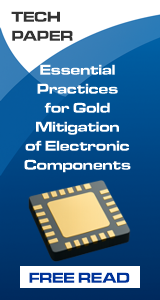|

|
|
|
||||||||
Hand Soldering Reliability
Board Talk
|
||||||||
TranscriptPhil And welcome to Board Talk, the Assembly Brothers, pick and place, who also go by ITM Consulting. Today we are trying to solve your process problems at ITM headquarters. We have a question from P.K. today. P.K. says on occasion we have had to place a skip in our SMT placement machine due to unavailability of a surface mount component. The intention is to build the circuit card assembly using pick and place then and solder the missing components when available, except that there are times when you have to rework a job to replace the components but these should be kept to a minimum. Can you comment on potential differences in reliability for SMT machine placement followed by reflow soldering vs. hand placement followed by hand soldering in surface mount? Jim The basic thing is an automated process you are as good as your machines. In a hand process you are as good as your operators. Now operators can be very good. You assume they are properly trained. You should be able to get as good solder joints and accurate placement as the automated process. In fact, I could argue that you should be able to get better soldering because with hand soldering you can custom adjust the process to each specific joint. When you go through a reflow oven, all of the joints on a component and on a board see the same time temperature profile. With hand soldering you can adjust the exact amount of time you have to get the perfect wetting and so forth. Assuming that your operators are trained and disciplined, you should be able to get good mechanical solder. The problem from a reliability standpoint is chemical and has to do with flux residues. If you are cleaning, you must clean the entire assembly, the whole board. Localized cleaning does not work, it tends to move residues and bad chemicals under your adjacent components and cause long term reliability issues. If you are using a no-clean process you have to make sure that all of the no-clean fluxes on there were completely heated such that they are fully deactivated. Phil One of the other things is to not necessitate the need for cleaning in this case cosmetics, is to use as little flux as possible. Again, as Jim emphasized, not only in positioning the component but in the soldering. Have a very well-trained operator doing this to minimize the amount of flux so there is not a lot of residue left over, assuming you are using no clean. Otherwise, if you are going to clean it great go for it. Jim No flux bottles. They should not be allowed on your floor. The proper way when hand soldering with no-clean is to use cord wire solder so that all of the flux is in the solder wire. It only comes out when the solder melts so therefore you have the best chance that all of that flux will be properly heated and therefore deactivated leaving a safe residue on the board. If you have to add a little more flux, which we hate to even allow, use a flux pen that will just apply where it is touched. Once you start dripping liquid flux on a board that flux is inevitably going to run away, get under something and more importantly not be heated completely and therefore not deactivated, leaving active flux chemistry on the board that can affect the long-term reliability of your product. Phil As Jim also said, right now in the industry as we speak there is no such thing as selective cleaning. Select soldering yes, but selective cleaning no. The other thing is never clean up something strictly for cosmetics. This is the classic example of doing more harm than good. Well, I hope we answered P.K.'s question here and other people too. I am sure we will hear comments on this. In the meantime, whether you are going to put it through a reflow machine, or hand soldering, or laser soldering induction whatever method you use, don't solder like my brother. Jim And don't solder like my brother. |
||||||||
Comments
|
||||||||
|
|

|




